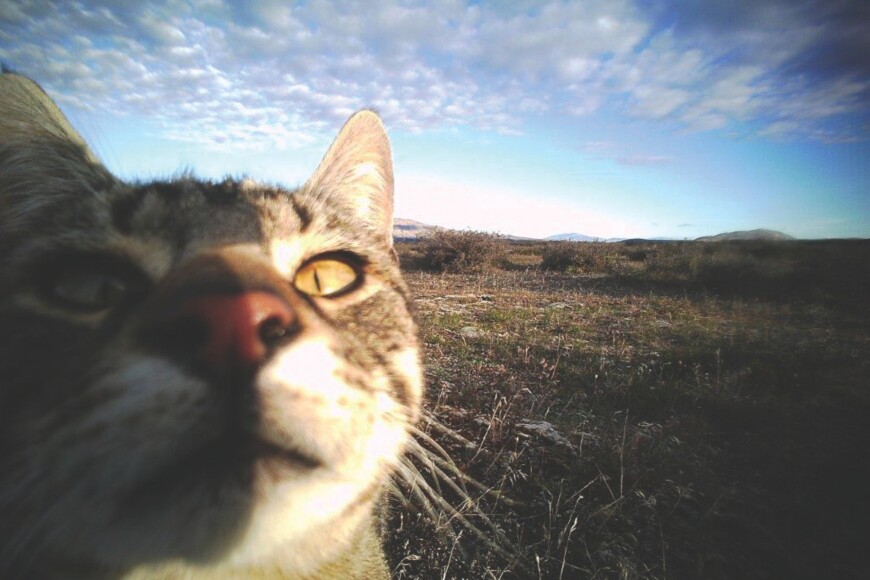AoNZ also has significant numbers of stray cats (that partly rely on people) and feral cats, originally descended from domestic cats (so, also Felis catus) but which live independently and don’t depend on or interact with humans. Exact numbers of feral cats are unknown, although work is underway to model and map their population densities and detectability. They are widespread across the country, in habitats including coastal areas, farmland, forests, riverbeds, sub-alpine environments and islands.
Cats of all three types are a major ecological problem worldwide – they are opportunistic broad-spectrum predators that contribute globally to biodiversity loss. In AoNZ, household, stray and feral cats prey on rabbits and hares, rats and mice, but they also take bats, lizards, birds and bird eggs, wētā and other insects.

Feral cat interacting with trail camera
But cat management to enhance ecological outcomes is controversial, especially any form of lethal management, because cats are highly valued as companion animals. As a result, a suite of non-lethal approaches to reduce cat impacts on native biodiversity is needed, as well as the careful development of public support (also known as “social licence”) for such approaches.
To address this need, as part of an MBIE-funded Smart Idea research programme, scientists at Manaaki Whenua have tested whether sound cues can deter cats from specific locations. The researchers played sounds of human voices, dogs and cats to test whether these induced fleeing and avoidance behaviours in cats and kept them from exploiting areas where food was placed. The first part of the trial used cats in an enclosure, and the second part of the trial was done in an open suburban area, where cat presence was measured using trail cameras.
In the enclosure trial, human playbacks protected the greatest proportion of food patches, were more likely to reduce time cats spent feeding, and induced more fleeing responses and spatial avoidance than competitor dog and cat playbacks. Cat and dog playbacks were effective in protecting food patches but induced fewer fleeing and avoidance responses. In the open area trial, cat and human playbacks were effective, and these are promising for further testing. The researchers are currently integrating playbacks into a management tool to repel cats from areas where they are not wanted but lethal control is not feasible.
Additionally, work has been done at Manaaki Whenua to establish cat owners’ willingness to adopt new cat control measures. Keeping cats indoors at night is an often-cited solution to the problem of cat predation on native species, but is it a realistic suggestion to make? A survey of 2000 cat owners across the country suggests not – at least, not yet: cat owners will mostly or always keep their pets indoors at night only if they have high involvement with cat welfare and a strongly favourable attitude towards keeping cats inside. The survey also showed that concern for cat welfare must be built-in to any cat control solutions. Owners were unlikely to keep cats inside in the long term if promotional material focused solely on the harm that cats do to wildlife, but they might be more prepared to do this if cat-friendly, inexpensive, practical, and easily maintained devices are available that enable cats to be kept inside.
Similarly, whether cat owners put collars on their cats depended on their attitude towards protecting wildlife from cats and their beliefs about the effectiveness of protective devices. If protective devices such as bibs attached to collars are effective, or their effectiveness can be improved, they may offer an inexpensive and practical alternative to keeping cats indoors at night. A campaign promoting the use of these devices would need to offer persuasive evidence that they work and are safe for cats to wear – again, highlighting the importance of cat welfare in the public mind.
These studies are important foundations for understanding the motivations and beliefs of cat owners. The aim of developing non-lethal cat-control tools with built-in social licence to operate is ambitious, but herding cats is perhaps not as difficult as the phrase suggests.
A little-appreciated ecological problem caused by cats
Toxoplasmosis, caused by an intestinal parasite called Toxoplasma gondii has been confirmed as a cause of death of endangered Hector’s dolphins and critically endangered Maui dolphins. T. gondii reproduces only in cats. The egg-like oocysts of the parasite spread from cat faeces into the environment, and can travel via surface water run-off to the sea. Toxoplasmosis causes abortions in infected sheep, goats and pigs, and vaccinations and lamb losses can be a significant cost to the farming sector. Dolphins can become infected when parasites from cat faeces end up in the marine food chain. The parasite can also affect humans, and if a pregnant woman gets infected via contact with cat faeces, birth defects are possible. Researchers from Manaaki Whenua have modelled the potential spread of toxoplasmosis by feral cats on farmland, and are currently modelling the transmission of toxoplasmosis by feral cats in the catchment area affecting the Maui dolphins.
A cat-astrophe for native species
Studies have shown feral cats have a devastating effect on native species. Here are some examples (from the Department of Conservation).
- In 2020, a feral cat caught in Canterbury had 17 skinks in its stomach.
- In 2010, a feral cat in Ohakune killed 107 bats/pekapeka in just one week.
- From 2019 to 2021, feral cats caused the death of 20% of monitored kea in Arthur’s Pass.
Key contact

